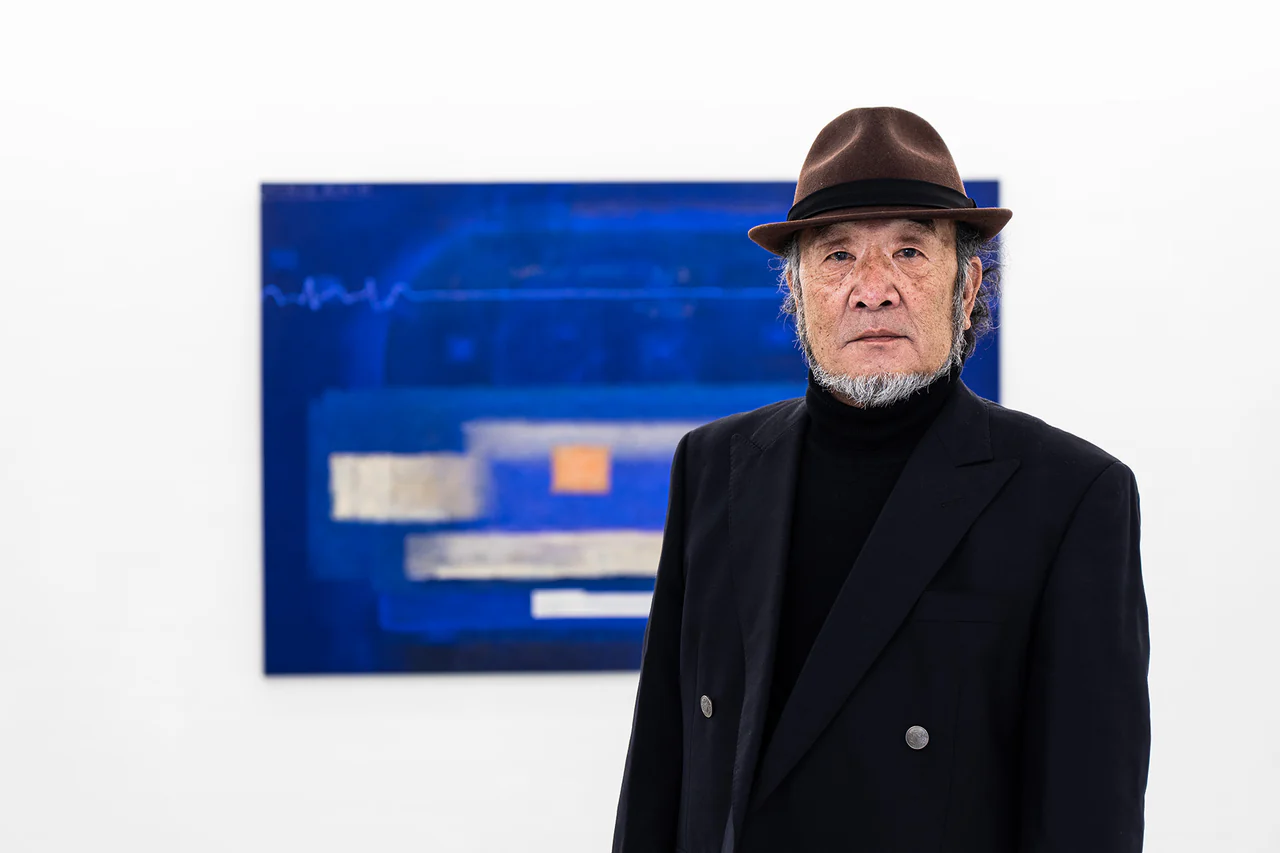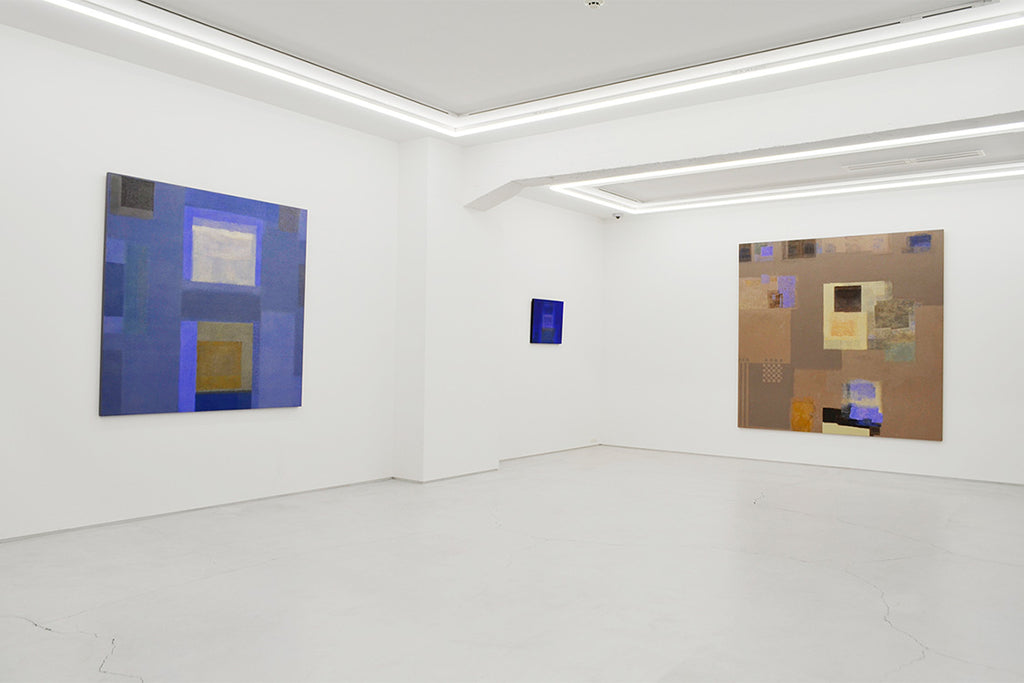ARTICLES
A New Frontier for Inokuma Blue | Katsuyoshi Inokuma "Transition" Interview
2023.03.08
INTERVIEW

See canvases painted in a deep and tranquil, brilliant blue. Whitestone Ginza New Gallery is showcasing a solo exhibition, "Transition," by artist Katsuyoshi Inokuma, known for artworks painted in his signature ultramarine blue color, "Inokuma Blue." The exhibition features Inokuma's early paintings from the 1970s right up to his latest works. In this interview, we look back on his 50-year long artist career, sharing his journey in the birth of Inokuma Blue and his latest works reflecting his experience in surviving cardiac arrest.

“Turning a Cardiac Arrest Experience into a Work of Art

From the exhibition view, Katsuyoshi Inokuma "cardiac arrest 9/s" (2022), 121.0 × 182.0 cm, acrylic and coffee powder on canvas
The exhibition "Transition”, explores Inokuma's approach to painting and how his works have changed and evolved over the years and unveils a hidden theme in his new work "cardiac arrest 9/s".
Inokuma experienced a cardiac arrest for 9 seconds recently. This near-death experience served as a catalyst that significantly changed the painting style he had established for himself.
Inokuma: Before that experience, it was unthinkable to put words in my paintings. But for some strange reason, I didn't feel any reluctance when I was creating the new work. I strongly felt that it needed to have words on it. I also naturally thought that it should depict an electrocardiogram. I didn't have any misgivings about trying something new.
From Figurative to Abstract Art, and a Fascination for Deep Blue

The exhibition view
Inokuma studied art in the Yokohama University of Art and Design, but he only dedicated himself to painting when he was already in his 40s. Soon after, he won the Aoki Shigeru Memorial Award in 1996, and the Fukushima Prefectural Art Exhibition semi-grand prize in 1998. During the 1970s to the 1980s, he mostly created self-portraits and figurative paintings that, although subdued, made use of various colors. It was "IN THE BLUE", the painting that won him the Aoki Shigeru Memorial Award, that laid the foundations for his eponymous "Inokuma Blue".
ー Having won awards for abstract paintings, your shift to abstract art seems to be an important junction in your career. What made you decide to create abstract paintings?
Inokuma: No specific moment led to this, but there was one time when I saw the free drawing style from an artist named Gunji Fukasawa. When experimenting with line art and free drawing, I couldn't achieve what I wanted, no matter how much I tried. Finally, I realized I should follow my intuition and honestly express my art. Partly because I'm an introvert, I became fascinated with abstract expression. I started creating abstract art in the 1980s but didn't know much about it then. I simply began by applying colors onto a canvas.

The exhibition view
ー After trying abstract expression, how did your idea of figurative expression change?
Inokuma: As you can see from my paintings, although they are abstract expressions, I have consistently considered them figurative when occupying space. I don't want my paintings to be a plain wall when displayed. That's why the expressions are abstract, but I strongly feel they should be concrete representations of space.
Origins of "Inokuma Blue"

The exhibition view
Inokuma's signature color "Inokuma Blue" is a result of a creative experiment. By mixing used coffee powder with blue paint, a delicate texture is achieved on the paint surface, which further enhances the tranquil blue.
ー How do you go about creating a painting?
Inokuma: I first apply a pink base. If I use a white underpainting, the blue becomes too intense. By applying the blue on top of a pink layer, a subdued blue is achieved.
Also when I apply the blue, I leave intentional brush strokes. By using firm strokes, I can create a delicate paint surface. Painting the brushstrokes is important but it's also important to do this step repeatedly. Colors should be painted with the lightest color then gradually layered with darker colors. This allows me to paint the entire surface evenly.
For the final step, I polish the surface with sandpaper. By applying the paint repeatedly over many layers, I can bring out the same finishing no matter where I polish.

ー You are known for your signature deep blue color called "Inokuma Blue". How do you choose the colors you use in a painting?
Inokuma: I don't use a lot of colors, maybe 10 different colors at most. Most of the time, I mix the colors myself. For example, to make gray or sepia, I mix white and black and yellow. The colors I want to express change slightly depending on their adjacent colors, so I always fine-tune the colors in each painting.
For the pink underpainting, I use a color called Luminous Opera as a base. It took me a very long time to create the current shade of pink that I use.

Inokuma's studio, in front of his paints are the tools he uses to sand and polish his paintings.
Taking on a New Challenge in his 70s

ー This exhibition is like a retrospective exhibition that features your early works up to your latest paintings. How do you feel when you look back on your life as a painter?
Inokuma: By looking back at the past, I have made new discoveries.
Just as a farmer can get stuck in a rut plowing the same field over and over, I sometimes feel like I've hit a creative block. And now that I'm over 70 years old, I also worry about my health, given the fact that I've already experienced cardiac arrest. Even so, it was because of that experience that I was able to create a new painting with a different theme.
Through those experiences, and with more time to reflect on my past works, I feel like my repertoire as an artist has increased. There is a growing desire in me to take on new challenges where I can express myself more freely in my paintings.

Inokuma in his art studio
Whether it’s mixing coffee powder with paint, finishing paintings by scratching, or using a syringe to paint, Inokuma continues to look for new and unique creative methods to this day. His signature deep blue color has a tranquility that seems to absorb even light, yet it also has a brilliance that enchants you. Just like his paintings, Inokuma himself seems reticent at first glance, but was all smiles when he shared anecdotes from his life, like how a cat walked on his paints while he was painting, or how he used his wife as his model. Although he looks back on his life with fondness, one can also feel a strong will to leave his mark as an artist.
The Katsuyoshi Inokuma exhibition "Transition" will be held at the Whitestone Ginza New Gallery from March 10th to April 1st. You can also view the exhibition details through our website.

